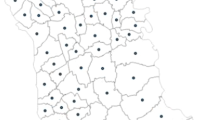Abstract
The sectorization problem is a particular case of partitioning problems occurring in cartography. The aim is to partition a territory into sectors such that the statistical activity measure of each sector is as close as possible to a given target value. We model this as a problem of minimizing the maximum deviation among all the sectors between their activity measure and their target value. We propose a mathematical programming formulation for the problem, we add some valid inequalities to restrict the solution space and develop a preprocessing procedure to reduce the number of variables. Computational results on different maps highlight the strong efficiency of this reduction procedure.



Similar content being viewed by others
References
Baptiste, P., Della Croce, F., Grosso, A., & T’kindt, V. (2010). Sequencing a single machine with due dates and deadlines: an ILP-based approach to solve very large instances. Journal of Scheduling, 13(1), 39–47.
Berman, O., Drezner, Z., Tamir, A., & Wesolowsky, G. O. (2009). Optimal location with equitable loads. Annals of Operations Research, 167, 307–325.
Bozkaya, B., Erkut, E., & Laporte, G. (2003). A tabu search heuristic and adaptive memory procedure for political districting. European Journal of Operational Research, 144, 12–26.
Bozkaya, B., Erkut, E., Laporte, G., & Neuman, S. (2005). Political districting: solving a multi-objective problem using tabu search. Boston: Kluwer Academic.
Charikar, M., Chekuri, C., Cheung, T., Dai, Z., Goel, A., Guha, S., & Li, M. (1999). Approximation algorithms for directed Steiner problems. Journal of Algorithms, 33, 73–91.
Daskin, M. S. (1995). Network and discrete location: models, algorithms and applications. New York: Wiley.
Dreyfus, S. E., & Wagner, R. A. (1972). The Steiner problem in graphs. Networks, 1, 195–207.
Drezner, Z., & Hamacher, H. W. (2004). Facility location: applications and theory. Berlin: Springer.
Eiselt, H. A., & Sandblom, C.-L. (2004). Decision analysis, location models, and scheduling problems. Berlin: Springer.
Feremans, C., Labbe, M., & Laporte, G. (2002). A comparative analysis of several formulations for the generalized minimum spanning tree problem. Network, 39(1), 29–34.
Garfinkel, R. S., & Nemhauser, G. L. (1970). Optimal political districting by implicit enumeration techniques. Management Science, 13, 495–508.
Grilli di Cortona, P., Manzi, C., Pennisi, A., Ricca, F., & Simeone, B. (1999). Evaluation and optimization of electoral systems. SIAM monographs on discrete mathematics and applications. Philadelphia: SIAM.
Hansen, P., & Jaumard, B. (1997). Cluster analysis and mathematical programming. Mathematical Programming, 79, 191–215.
Hess, S. W., Weaver, J. B., Siegfeldt, J. N., Whelan, J. N., & Zhitlau, P. A. (1965). Nonpartisan political districting by computer. Operations Research, 13, 998–1006.
Kalcsics, J., Nickel, S., Puerto, P., & Rodríguez-Chía, A. (2010). The ordered capacitated facility location problem. An Official Journal of the Spanish Society of Statistics and Operations Research, 18, 203–222.
Karypis, G., & Kumar, V. (1998). A fast and high quality multilevel scheme for partitioning irregular graphs. SIAM Journal on Scientific Computing, 20(1), 359–392.
Kernighan, B., & Lin, S. (1970). An efficient heuristic procedure for partitioning graphs. The Bell System Technical Journal, 49(2), 291–307.
Mehrotra, A. (1992). Constrained graph partitioning: decomposition, polyhedral structure and algorithms. Ph.D. thesis, Georgia Institute of Technology, Atlanta, GA
Mehrotra, A., Johnson, E. L., & Nemhauser, G. L. (1998). An optimization based heuristic for political districting. Management Science, 44, 1100–1114.
Miller, C., Tucker, A. W., & Zemlin, R. A. (1960). Integer programming formulation of the travelling salesman problem. Journal of the Association for Computing Machinery, 7, 326–329.
Nemhauser, G. L., & Wolsey, L. A. (1999). Integer and combinatorial optimization. New York: Wiley-Interscience.
Osorio, M. A., Glover, F., & Hammer, P. (2002). Cutting and surrogate constraint analysis for improved multidimensional knapsack solutions. Annals of Operations Research, 117, 71–93.
Ou, C., Ranka, S., & Fox, G. (1996). Fast and parallel mapping algorithms for irregular and adaptive problems. Journal of Supercomputing, 10, 119–140.
Patra, A., & Kim, D. (1998). Efficient mesh partitioning for adaptive hp finite element methods. In International conference on domain decomposition methods.
Savelsberg, M. W. P. (1994). Preprocessing and probing techniques for mixed integer programming problems. ORSA Journal of Computing, 6, 445–454.
Schloegel, k., Karypis, G., & Kumar, V. (2000). Graph partitioning for high performance scientific simulations. In J. Dongarra, I. Foster, G. Fox, K. Kennedy, & A. White (Eds.), CRPC parallel computing handbook. San Mateo: Morgan Kaufmann.
T’kindt, V., Della Croce, F., & Bouquard, J.-L. (2007). Enumeration of Pareto optima for a flowshop scheduling problem with two criteria. INFORMS Journal on Computing, 19(1), 64–72.
Tarjan, R. (1972). Depth-first search and linear graph algorithms. SIAM Journal on Computing, 1, 146–160.
Teitz, M. B., & Bart, P. (1968). Heuristic methods for estimating the generalized vertex median of a weighted graph. Operations Research, 16, 955–961.
van Roy, T. J. (1986). A cross decomposition algorithm for capacitated facility location. Operations Research, 34, 145–163.
Author information
Authors and Affiliations
Corresponding author
Rights and permissions
About this article
Cite this article
Tang, X., Soukhal, A. & T’kindt, V. Preprocessing for a map sectorization problem by means of mathematical programming. Ann Oper Res 222, 551–569 (2014). https://doi.org/10.1007/s10479-013-1447-8
Published:
Issue Date:
DOI: https://doi.org/10.1007/s10479-013-1447-8




